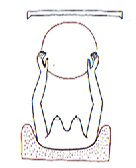Beyond the central hinge in time, the pair Spica and Alcor (rising with the Sun in October 10 and in principle visible close to the Full Moon in April 12), there were first 5 days followed by an ariki (king) glyph:
We can compare with the G tablet, where glyph 472 (counted from Gb8-30) is the last one on side b and the first glyph on side a then can be regarded as number 473 = 365 + 108. However, the tiny dot in front of the hanging maro in Cb8-11 should convince us that instead the cycle should be 1½ * 314 = 471. And Benetnash is η Ursae Majoris, the chief of the mourners, which implies the other end of the sky (year) ought to be a happy time because of birth - an uplifting place:  
Where the hinge of the clam was located there could only be poor visibility and the 7th Greek letter (alluding to Saturn) is Η which may have been associated with strings:
... A very detailed myth comes from the island of Nauru. In the beginning there was nothing but the sea, and above soared the Old-Spider. One day the Old-Spider found a giant clam, took it up, and tried to find if this object had any opening, but could find none. She tapped on it, and as it sounded hollow, she decided it was empty. By repeating a charm, she opened the two shells and slipped inside. She could see nothing, because the sun and the moon did not then exist; and then, she could not stand up because there was not enough room in the shellfish. Constantly hunting about she at last found a snail. To endow it with power she placed it under her arm, lay down and slept for three days. Then she let it free, and still hunting about she found another snail bigger than the first one, and treated it in the same way. Then she said to the first snail: 'Can you open this room a little, so that we can sit down?' The snail said it could, and opened the shell a little. Old-Spider then took the snail, placed it in the west of the shell, and made it into the moon. Then there was a little light, which allowed Old-Spider to see a big worm. At her request he opened the shell a little wider, and from the body of the worm flowed a salted sweat which collected in the lower half-shell and became the sea. Then he raised the upper half-shell very high, and it became the sky. Rigi, the worm, exhausted by this great effort, then died. Old-Spider then made the sun from the second snail, and placed it beside the lower half-shell, which became the earth. South of the equator and on Easter Island - beyond the close of the cycle of 1½ * 314 days beginning with January 1 - the Sharatain Sign close to the Full Moon in October 15 could have announced a new year had been born with a pleasant summer ahead. The rest of the C text on side b could then stretch to the end of this 'summer year' and end with September 30 (where 273 = 3 * 91).
| |||||||||||||||||||||||||||||||||||||||||||||||||||||||||||||||||||||||||||||||||||||||||||||||||||||||||||||||||||||||||||||||


